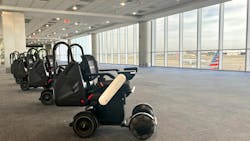Autonomous Chairs Now Taking American Airlines Customers to Gates at LAX and MIA
WHILL Inc.has announced the first commercial installations of its autonomous mobility service in the United States within American Airlines terminals at Los Angeles International Airport (LAX) and Miami International Airport (MIA).
One of the most common challenges affecting airports and airlines today is providing quality service to passengers with reduced mobility. These travelers are the fastest growing demographic in the airline industry and airports must adapt to meet their needs. Recent trends include more wheelchair pushes, longer wait times, and an increased number of staff injuries. With the global population aging and projected to reach 2.1 billion people over 60 by 2050 (Source: WHO), WHILL’s autonomous mobility service will improve accessibility for customers around the world.
“We are thrilled to bring cutting-edge technology and innovation to two of American’s busiest hubs,” said Shane Bogni, Vice President of Business Development at WHILL Mobility Services, North America. “Our autonomous mobility services offer customers increased independence, reduced wait times, and an enhanced customer experience.”
WHILL and Envoy Air, a wholly owned subsidiary of American Airlines Group, have been collaborating since late 2022 at Miami International Airport (MIA) and Los Angeles International Airport (LAX). The thorough testing of the service has resulted in excellent performance and positive customer feedback. Once a user selects their destination on a touch screen, the WHILL autonomous power chair takes over, safely and reliably transporting the customer to their desired gate.
“The Envoy team at MIA supports thousands of customer service requests every day, and we’re thrilled to partner with WHILL to pioneer the introduction of this autonomous mobility service in the U.S.,” said Migdoel Rosa, Envoy Vice President of MIA Hub.
“Ensuring accessibility and safety for our customers are top priorities for our team,” added Deesha Desai, Envoy Vice President of LAX Hub and Western Region. “Our team and WHILL are committed to listening to customers and addressing their needs, which will result in an improved experience for individuals with accessibility challenges.”
